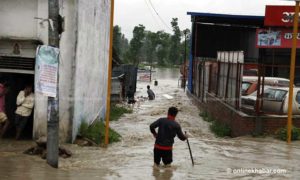
File
It is often said that disasters do not come with a warning, but in Nepal, geological and water-related disasters occur every year. If we look at the five years from July 2019 to June 2023, there have been over 2,800 incidents, resulting in more than 800 fatalities. Additionally, over 3,000 infrastructures have been damaged, with losses amounting to billions of rupees. These statistics do not include indirect losses such as the financial impact on families who have lost livelihoods and jobs due to the disasters, and the investments made in unproductive areas due to the disasters.
Despite the numerous organisations working on disaster mitigation, management, and resilience, the annual significant losses over the past decades indicate that we need to be more prudent in mainstreaming disaster risk reduction.
The United Nations Office for Disaster Risk Reduction has pointed out that while most hazards are natural, disasters are largely caused by human actions. Our developmental activities might be turning hazards into disasters. Hence, it is essential for development activities at the community level to be risk-sensitive and for individuals to be risk-aware.
Before undertaking such activities, we must be able to answer various questions: Are our activities contributing to the creation of hazards? Are our activities exacerbating the impact of local small-scale hazards? Have we conducted potential disaster assessments and their mitigation or minimisation while carrying out our activities? Are our activities appropriate according to local needs?
Disaster management requires both technical and non-technical expertise. While the creation of disasters is often technical, their mitigation, minimisation, and recovery require consideration of both technical and non-technical aspects. The separation of technical and non-technical aspects into different plans in our development and disaster management projects poses a challenge to mainstreaming disaster management.
In Nepal, projects are currently built through two different processes: one based on community needs assessment and the other based on institutional objectives. When projects are built based on community needs assessment, disaster management is relatively mainstreamed. However, projects built on institutional objectives face difficulties in mainstreaming disaster management due to institutional constraints.
The roads we have built in the hilly and mountainous regions have caused many landslides. Given Nepal’s geologically risky terrain, it is crucial to conduct detailed geological studies sensitively before digging roads anywhere.
Similarly, the southern part of the country is affected by floods annually. Low-income landless communities in floodplain areas suffer significant damage due to floods. Flood risk mapping is not conducted, and successful community risk reduction practices are not included in annual plans. The lack of inclusion of basic activities like disaster, vulnerability, exposure, and risk studies in plans aimed at resilience in these areas is a reason for the failure of mainstreaming disaster management.
Mainstreaming itself is a complex process that demands high resources and broad expertise. Identifying the necessary human and non-human resources for micro-level studies on disaster and hazard assessment, vulnerability, exposure, and risk evaluation is essential.
Currently, there is sufficient human expertise available domestically and internationally, so availing services is not an issue. However, the limited non-human resources for disaster management need to be used appropriately.
All three levels of government have started allocating budgets for disaster management. Disaster management funds have been established at all three levels as per the provisions of the Disaster Management Act.
These funds do not freeze, and annual allocations continue to grow. However, the frequent need to use these funds for relief due to recurring small and large disasters prevents the fund size from significantly increasing.
Investing the funds in disaster preparedness could lead to a shortage of funds for response and relief, creating a potential challenge for the government. These challenges make it more difficult to use disaster management funds for mainstreaming. Therefore, it seems necessary to include disaster management not only in disaster management funds but also in regular construction and service activities




















